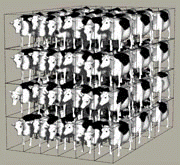Animal Science, Department of

World Congress on Genetics Applied to Livestock Production: 3rd (1986)
Date of this Version
1986
Abstract
Cattle breeds native to tropics are late maturing and poor producers of milk and beef, but have the ability to survive under harsh tropical environments. In spite of large, genetic variability for milk yield. selection for productive traits would not be effective in bridging the gap between requirements of human food and its availability. Other methods to achieve these goals have been suggested. Breed comparison studies are needed to identify special genes for fast growth, efficient breeding and resistance to diseases and drought capacity, alternatives like replacement of native with improved European breeds and gene transfer through crossbreeding have been discussed. The results of various crossbreeding experiments in the context of [i] importance of native breeds in crossbreeding. [ii] relative superiority of improver breeds used. [iii] optimum levels of improver inheritance and [iv] effects of inter-breeding among crossbreds have been examined. The success and future of the new developed breeds from crossbred foundations in the changing socioeconomic conditions has been discussed. Larger proportions of Holstein genes in crossbreds has been suggested. Crisscross breds and stabilised crossbreds are on increase for beef production. Feed lot technology offers a great potential for increasing beef production using agro-industrial by-products not fit for human consumption.


Comments
Published in 3rd World Congress on Genetics Applied to Livestock Production, edited by Gordon E. Dickerson and Rodger K. Johnson, 4 vols. (Lincoln: University of Nebraska Institute of Agriculture and Natural Resources, 1986). Copyright © 1986 Board of Regents University of Nebraska.